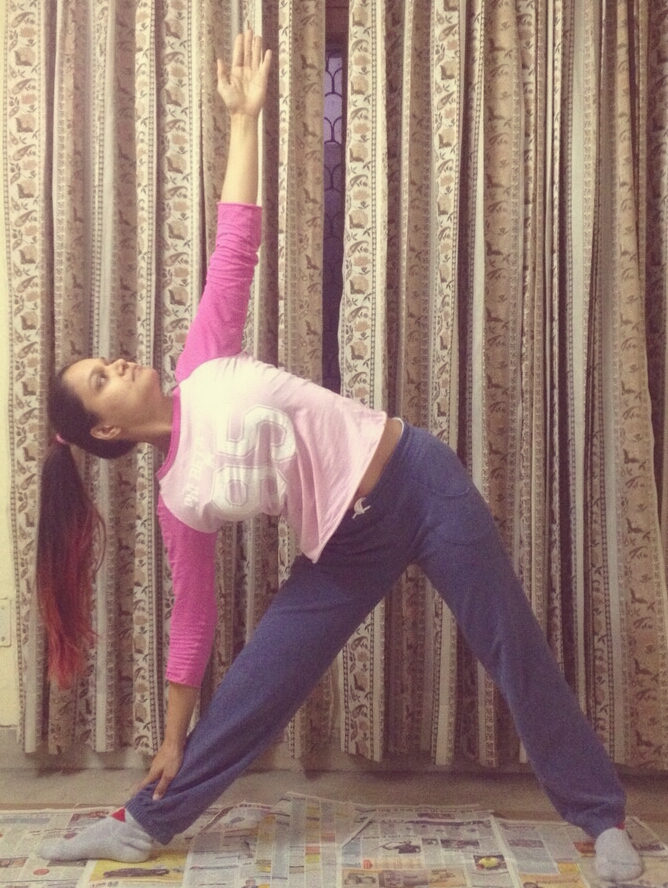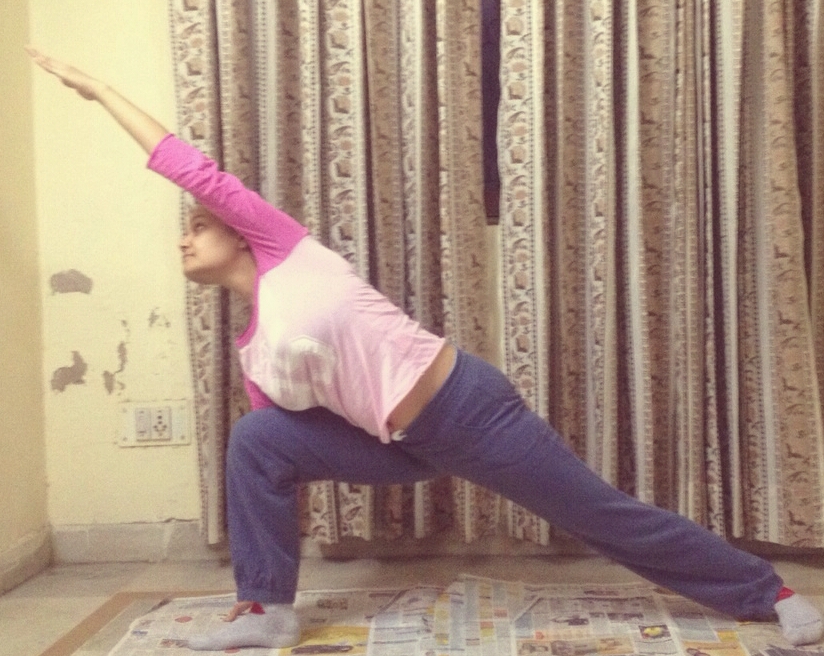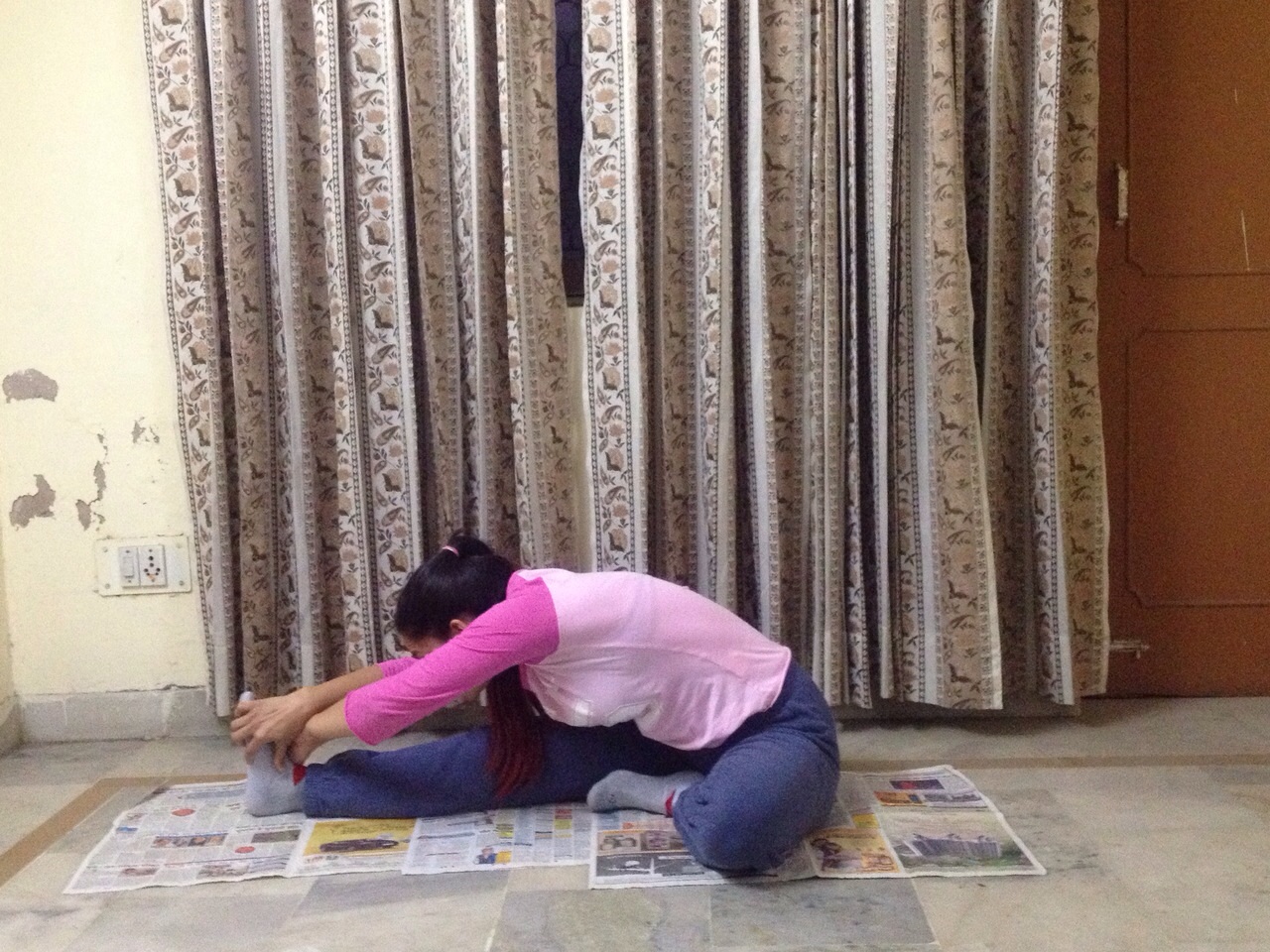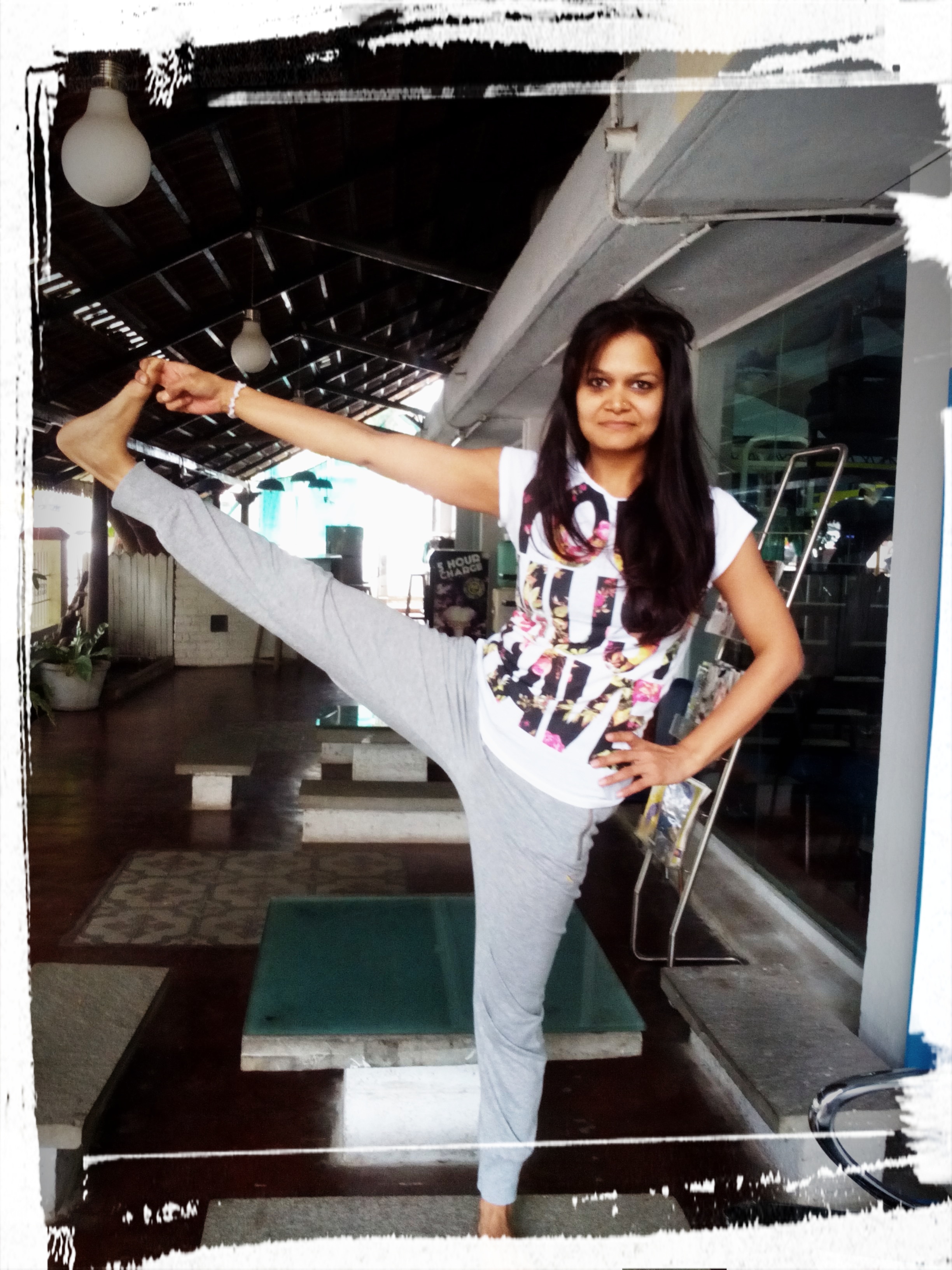Holding the Chaturanga for 2 minutes is an awesome way to test your core and arm strength. If you want to make it a bit more challenging do the Chaturanga pushups. Basically you lower yourself towards the ground until your arms are parallel to your body and then push up into the regular plank.
Besides this you can do the little move demonstrated in this video:
https://www.youtube.com/watch?v=HWb3tAgFlfE
The Adhomukha Svanasana is an awesome way to stretch the entire body. The picture below is not a great one of the pose since I’m wearing socks (extremely cold in Delhi) and my sister doesn’t have a yoga mat (still recovering from shock). However, remember that this asana is also about core strength. You want to use your core strength to elongate your spine. Push your index finger and thumb into the floor to lift and lengthen your body. The stretch on both sides of the body should be equal, so if you feel you are engaging your right hand more (as most right handed people tend to do), then actively start to push your left into the floor. Your heels DO NOT need to touch the floor. However, you need to ensure that the back of your legs are  also stretched. The heels should not lean in towards each other, they should be pushed slightly away from each other. The challenge in the Adhomukha Svanasana is to elevate the tailbone as much as you can, without compromising the length of the spine.
also stretched. The heels should not lean in towards each other, they should be pushed slightly away from each other. The challenge in the Adhomukha Svanasana is to elevate the tailbone as much as you can, without compromising the length of the spine.
This asana is to be practiced on arms day because it’s through arm work that you’ll be able to lengthen and straighten the spine. Work on opening up the shoulders and pushing the shoulder blades closer to each other. Bring awareness even to the armpits and see if you’re able to feel a stretch in the armpits as well.
Finally practice the Gomukhasana to get an intense stretch on the arms, shoulders,  chest and shoulder blades. A lot of people tend to bend the elbow which is up (in the picture below the right elbow) forward. Actively push both elbows back. Elevate the spine. Push both feet into the floor for a greater lift. Hold it for 2 minutes on each side and you’ll start to feel your body opening up.
chest and shoulder blades. A lot of people tend to bend the elbow which is up (in the picture below the right elbow) forward. Actively push both elbows back. Elevate the spine. Push both feet into the floor for a greater lift. Hold it for 2 minutes on each side and you’ll start to feel your body opening up.

 There should be a uniform stretch along the side of your body. Make sure the side of your body doesn’t rest on the thigh. To ensure this you may want to slightly lift your hand off of the floor ensuring your core and your legs have to support your body weight. Look up at your finger tips. Relax your neck and face.
There should be a uniform stretch along the side of your body. Make sure the side of your body doesn’t rest on the thigh. To ensure this you may want to slightly lift your hand off of the floor ensuring your core and your legs have to support your body weight. Look up at your finger tips. Relax your neck and face. Do this pose in the end to stretch the back of your legs. However, in this pose, as in all other poses, pay attention to your core. You want to make sure that you pull your stomach in and extend forward keeping your back straight. This will ensure a deeper stretch. Aim to get your chin to the knee instead of forehead to knee. Also, make sure you cross your arms when you reach forward. This ensures that the stretch on your back is even.
Do this pose in the end to stretch the back of your legs. However, in this pose, as in all other poses, pay attention to your core. You want to make sure that you pull your stomach in and extend forward keeping your back straight. This will ensure a deeper stretch. Aim to get your chin to the knee instead of forehead to knee. Also, make sure you cross your arms when you reach forward. This ensures that the stretch on your back is even.


![IMG_20141026_122003[1]](https://yogawithpragya.com/wp-content/uploads/2015/01/img_20141026_1220031-1.jpg?w=225)
![IMG_20141231_160302[1]](https://yogawithpragya.com/wp-content/uploads/2015/01/img_20141231_1603021-1.jpg?w=293)
![IMG_20141030_223059[1]](https://yogawithpragya.com/wp-content/uploads/2015/01/img_20141030_2230591-1.jpg?w=225)
![IMG-20141113-WA0000[1]](https://yogawithpragya.com/wp-content/uploads/2014/11/img-20141113-wa00001-1.jpg?w=300)
![IMG_20141113_092213[1]](https://yogawithpragya.com/wp-content/uploads/2014/11/img_20141113_0922131-1.jpg?w=225)
![IMG_20141113_092155[1]](https://yogawithpragya.com/wp-content/uploads/2014/11/img_20141113_0921551-1.jpg?w=225)
![IMG_20141113_091723[1]](https://yogawithpragya.com/wp-content/uploads/2014/11/img_20141113_0917231-1.jpg?w=225)
![IMG_20141113_091901[1]](https://yogawithpragya.com/wp-content/uploads/2014/11/img_20141113_0919011-1.jpg?w=300)
![IMG_20141113_092055[1]](https://yogawithpragya.com/wp-content/uploads/2014/11/img_20141113_0920551-1.jpg?w=300)
![IMG_20141113_092238[1]](https://yogawithpragya.com/wp-content/uploads/2014/11/img_20141113_0922381-1.jpg?w=300)
![IMG_20141113_091825[1]](https://yogawithpragya.com/wp-content/uploads/2014/11/img_20141113_0918251-1.jpg?w=300)
![IMG_20141113_092120[1]](https://yogawithpragya.com/wp-content/uploads/2014/11/img_20141113_0921201-1.jpg?w=300)








